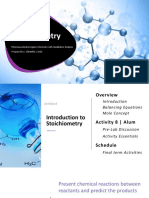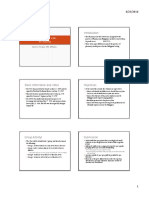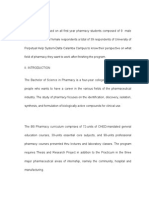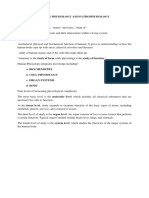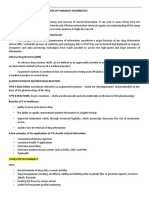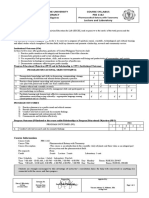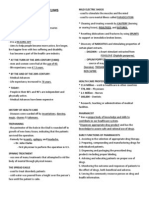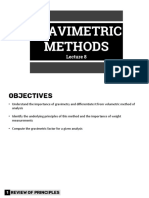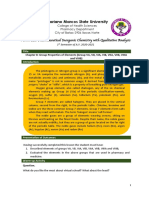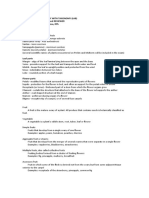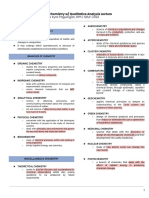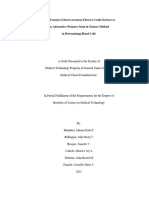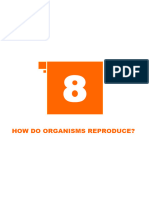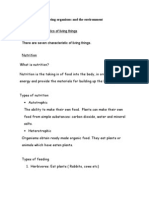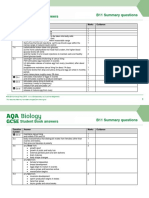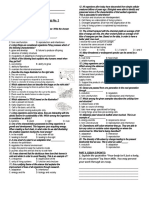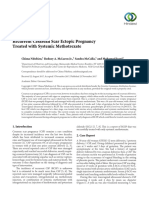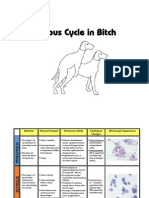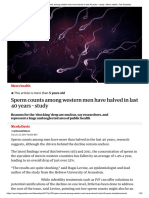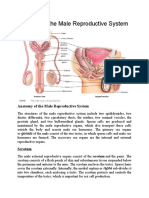Pharmaceutical Botany With Taxonomy
Pharmaceutical Botany With Taxonomy
Uploaded by
leahge.workCopyright:
Available Formats
Pharmaceutical Botany With Taxonomy
Pharmaceutical Botany With Taxonomy
Uploaded by
leahge.workOriginal Title
Copyright
Available Formats
Share this document
Did you find this document useful?
Is this content inappropriate?
Copyright:
Available Formats
Pharmaceutical Botany With Taxonomy
Pharmaceutical Botany With Taxonomy
Uploaded by
leahge.workCopyright:
Available Formats
ECONOMIC IMPORTANCE ▪ At the end of the story, any
• Food, spices, and drinks mature female plant will always
• Fuel contain 7 cells
• Drugs ▪ one of 7 cells have two, while all
the others have one nuclei in them
• Others
▪ 6 cells with one nuclei + 1 cell
o Carnauba wax as shoe polisher, dental
with two nuclei = 7 cells
floss
▪ 2 nuclei in one cell is called polar
o Ingredient of medicated soaps and creams
nuclei
FLOWERS ▪ In one mature plant, there are
7 cells
OVERVIEW
• Most interesting and eye catching
• Also have tissues
MALE AND FEMALE GAMETOPHYTE DEVELOPMENT
• Similar to how humans reproduce
Two kinds of spores:
• Microspores – anthers of flowers
• Megaspores – immature seeds-ovules
• Microspores Microgametophyte
o Mitosis; for male
o Usually diploid, complete number of
chromosomes
o Final product: haploid; 4 microspores which
become pollen grain
▪ Pollen grain - Immature male
gametophyte; partially developed
male gametophyte
▪ 4 microspores can become
another cell; vegetative cell and POLLINATION AND FERTILIZATION
generative cell
▪ Vegetative cell – pollen TERMS
▪ Generative cell – two sperm cells • Pollination
*last final product o Transfer of pollen grains from the anther
o Haploid - means incomplete and recipient is the pistil
• Megaspores or Megagametophyte o Sexual reproduction in flowering plants
o Meiosis; for female • Pistil
o Occur in polygonum plant famillies: o Stigma
▪ Brassicacea ▪ Where pollen grain is received as
▪ Graminae vegetative cell
▪ Malvaceae o Style
▪ Leguminosae ▪ Vegetative cell or pollen grain
▪ Solanaceae becomes a pollen tube for transit
o Both have diploid cells ▪ The “stem” or stalk; passageway
▪ Undergoes meiosis – cell division of pollen
▪ Miosis – means construction of ▪ Pollen tube – for transit; comes
pupils; counterpart is to dilate from vegetative cell
o Special because you can’t dictate what ▪ Generative divides to become
happens to it or its end product sperm cell
▪ Depends on the flowering plant o Ovary
o Lily ▪ Sperm cell or pollen grain needs
▪ One mother megaspore becomes to reach the ovary
4 haploids, 3 haploid will come ▪ Formation of ovules
together • Self pollination
▪ There will be one megaspore – o “Self-love”
loner megaspore o Genetic diversity is reduced
▪ 3 haploid megaspore – o Involves only one flower
disintegrates; “dead megaspores” o Pollen grains from the anther fall directly
▪ Only one haploid left – called the onto the stigma of the same flower
“functional megaspore” • Cross pollination
▪ One haploid megaspore o More complex
undergoes mitosis, three times o At least two flowers are two different
and becomes 8 free nuclei species
o Genetic diversity is increased
9 I ESPIRITU BSP 1-2
o Involves transfer of pollen from the anther o If the flower does not branch out, it is only
of one flower to the stigma of a different a peduncle
flower • Pedicels
o Agents of pollination: o Mini stalks holding individual flowers
▪ Wind • Receptacle
▪ Water o Cup that holds the flower
▪ Insects: butterflies, bees, bats, o Small pad resting at the tip of the
beetles, birds, also humans – peduncle or pedicel
transfers pollens from one flower
to another
• Flowers
o Essentially a short stem of several nodes
with short internodes between them
o Floral Shoot
▪ Does not have an apical meristem
that grows continuously
o Capable of producing flowers by
reproduction
o Dicots
▪ Magnoliopsida
o Monocot
▪ Liliopsida
PARTS OF THE FLOWER
• Receptacle
o Region of the flower shoot where the
flower parts are attached
• Calyx
o Group of sepals
• Corolla
o Group of petals
• Stamens and pistils
o Male and female part of flower
o Stamen – male
o Pistil – female
o Fertile parts
▪ Directly involved in reproduction
• Sepals and petals
o Sterile parts
STRUCTURES ▪ Helping in reproduction process
TERMS
• Embryonic primordium
o Develops into a bud
• Peduncle
o Tip of stalk; main stalk holding a group
of flowers
10 I ESPIRITU BSP 1-2
• Petals
o Corolla
▪ Most noticeable part of the flower
o Influences flower symmetry
Has two forms:
o Regular
▪ Radial symmetrical – equally
arranged in all directions;
identical parts are arranged in a
circular fashion around a central
axis; corolla developed equally
▪ Ex. Mustard, lily, oleander, poppy
o Irregular
▪ Bilateral symmetrical – left
and right still look the same
despite of having an imaginary
plane; equal arrangement of
parts about a vertical plane
• Stamens running from head to tail
o Collective term for male parts of the flower
o Consist of four-pollen containing chambers
that are fused into an anther which is
often on a stalk called filament
o Anther – pollen grains
o Filament – supports anther; a long tube
o Microsporangia
▪ Chambers where microspores are
produced
o Androecium
▪ Collective term for stamens
• Pistils
o Stigma
▪ Receptive area for pollen
o Style
• Sepals
▪ Supports the stigma; extends
o Leaf-like structure but may resemble
from the ovary
petals or intergrade with them
o Ovary
o May be fused into a tube and the a calyx
▪ Final destination
may be regular or irregular in its symmetry
▪ Ovule-bearing units
o Vital for the protection of a growing flower
▪ An enlarged basal portion
o Number of sepals
o Gynoecium
▪ Corresponds to number of other
▪ Collective term for carpels
floral parts
o Placentae
▪ Area where ovules are attached
within the carpels
FLOWER VARIATION
• Complete
o Major parts: sepals, petals, pistil, stamen
are present
• Incomplete
o One major part is missing
• Perfect
11 I ESPIRITU BSP 1-2
o Both stamen and pistil (androecium and
gynoecium) are present
• Imperfect
o Flower is only carpellate or staminate
▪ Only one of the stamen or pistil is
present
Question: Imperfect flowers are always incomplete. TRUE
• (-) stamen = incomplete
• (-) pistil = incomplete
Question: Incomplete flowers are always imperfect. FALSE
• (-) stamen = imperfect
• (-) pistil = imperfect
• (-) petals = perfect (still because pistil, stamen are
still present)
• (-) sepals = perfect (still because pistil, stamen are
still present)
Question: Incomplete flowers may or may not be imperfect.
TRUE
POSIITION OF OVARY
Hypanthium – floral tube; formed in a fushion of stamen,
petals, and sepals
• Hypogynous
o No hypanthium because floral tube is not
seen
o Ovary is superior
▪ Ovary is superior to point of
connection
• Perigynous
o Hypanthium is seen; extended below the
ovary
o Ovary is superior to the extension of point
of connection
• Epigynous
o Hypanthium is seen; fused at gynoecium
o Ovary is inferior; below point of connection
12 I ESPIRITU BSP 1-2
You might also like
- CH 11 4 Guided Cornell NotesDocument1 pageCH 11 4 Guided Cornell Notesapi-238397369No ratings yet
- Pharml Botany With Taxonomy Abus (22-23)Document7 pagesPharml Botany With Taxonomy Abus (22-23)Katrina CarolasanNo ratings yet
- Pharmaceutical Botany With TaxonomyDocument3 pagesPharmaceutical Botany With Taxonomyleahge.workNo ratings yet
- PHCP312 SyllabusDocument9 pagesPHCP312 SyllabusDanica PamintuanNo ratings yet
- PIPH SyllabiDocument7 pagesPIPH SyllabiRochelle Anne BandaNo ratings yet
- Mariano Marcos State University: Pharmaceutical Botany With TaxonomyDocument7 pagesMariano Marcos State University: Pharmaceutical Botany With TaxonomyKaizenNo ratings yet
- Perspective in Pharmacy ReviewerDocument3 pagesPerspective in Pharmacy ReviewerZyreeneNicoleNo ratings yet
- Stoichiometry IntroductionDocument79 pagesStoichiometry Introductionnicole675No ratings yet
- PIP Prelim TransesDocument14 pagesPIP Prelim TransespiaNo ratings yet
- Ancient Era From The Beginning of Time To 1600 AD: Theophrastus Known As The "Father of Botany" He Studied The AdverseDocument3 pagesAncient Era From The Beginning of Time To 1600 AD: Theophrastus Known As The "Father of Botany" He Studied The AdverseMichelle Yu0% (1)
- CEU Botany - LEAF/FLOWERSDocument5 pagesCEU Botany - LEAF/FLOWERSCutie JaeminNo ratings yet
- Perspective in Pharmacy Lesson 1Document10 pagesPerspective in Pharmacy Lesson 1Adya Aesha100% (1)
- Activity 1 - RA 10918 PDFDocument1 pageActivity 1 - RA 10918 PDFricaNo ratings yet
- Pha 613 Unit 2 HistoryDocument52 pagesPha 613 Unit 2 HistoryJuvelyn Kyle GugmaNo ratings yet
- Pharmaceutical Botany (PLANTS)Document10 pagesPharmaceutical Botany (PLANTS)yaoi yuri100% (1)
- Chapter 3 Essential Trace and Nonessential IonDocument8 pagesChapter 3 Essential Trace and Nonessential IonAnthony V. DaquilaNo ratings yet
- Unit 1: Introduction: Intended Learning OutcomesDocument7 pagesUnit 1: Introduction: Intended Learning Outcomesalibel caballeroNo ratings yet
- The Perspective of 1st Year BS Pharmacy Students in UPHSDDocument12 pagesThe Perspective of 1st Year BS Pharmacy Students in UPHSDAn LoNo ratings yet
- Human Physiology and PathophysiologyDocument1 pageHuman Physiology and PathophysiologyHewlett PearlNo ratings yet
- BiopharmaceuticalsDocument6 pagesBiopharmaceuticalsNikko Nabasca GorneNo ratings yet
- P Organic Chemistry-I PDFDocument2 pagesP Organic Chemistry-I PDFDevender KaushikNo ratings yet
- PCog Exercise No. 2Document5 pagesPCog Exercise No. 2Air LeighNo ratings yet
- UNIT 6 Pharmacy TrendsDocument3 pagesUNIT 6 Pharmacy TrendsJenilyn FarnacioNo ratings yet
- Botany Course Syllabus 2023-2024Document6 pagesBotany Course Syllabus 2023-2024Athea Mae P. TUYONo ratings yet
- Fields of BotanyDocument3 pagesFields of BotanyJESSMINE SABELLANONo ratings yet
- 3.2 Dispensing AdrDocument5 pages3.2 Dispensing Adrslu.laza.joeannNo ratings yet
- Pharcare 1 RPLMSDocument11 pagesPharcare 1 RPLMSDiah MarianoNo ratings yet
- Botany SpecializeBotany Specialized RootsBotany Specialized Rootsd RootsBotany Specialized RootsBotany Specialized RootsBotany Specialized RootsDocument5 pagesBotany SpecializeBotany Specialized RootsBotany Specialized Rootsd RootsBotany Specialized RootsBotany Specialized RootsBotany Specialized RootsBaltazar MarcosNo ratings yet
- PIPH History of Pharmacy PDFDocument96 pagesPIPH History of Pharmacy PDFSamuel Arellano100% (1)
- PHIN LectureDocument13 pagesPHIN Lecturedanilotinio2No ratings yet
- Topical AgentsDocument5 pagesTopical AgentsFemina Argonza100% (1)
- Evolution of PharDocument36 pagesEvolution of PharCyrusNo ratings yet
- Pharmacy Informatic Information Search ProcessDocument8 pagesPharmacy Informatic Information Search ProcessjackieNo ratings yet
- PharmAnal 8Document50 pagesPharmAnal 8Aaron Jhulian SimbitNo ratings yet
- Lesson 8Document11 pagesLesson 8KaizenNo ratings yet
- Pteridophytes PDFDocument80 pagesPteridophytes PDFJBNo ratings yet
- Lesson 3Document14 pagesLesson 3Kaizen100% (1)
- 1-History, Evolution and Milestone in PharmacyDocument29 pages1-History, Evolution and Milestone in PharmacyEliza Quines QuizonNo ratings yet
- Different Division of ZoologyDocument2 pagesDifferent Division of ZoologyEiann Jasper Longcayana100% (1)
- Perspective in Pharmacy SlidesDocument37 pagesPerspective in Pharmacy SlideschinNo ratings yet
- Activity 3.1 The Endomembrane SystemDocument4 pagesActivity 3.1 The Endomembrane SystemVelasco, Josiah M.No ratings yet
- Perspectives in PharmacyDocument1 pagePerspectives in PharmacyEmma Cristie BalahadiaNo ratings yet
- Physicochemical IncompatibilitiesDocument20 pagesPhysicochemical Incompatibilitiesvicbart11No ratings yet
- BS Pharmacy - ProspectusDocument9 pagesBS Pharmacy - ProspectusDomz BucadNo ratings yet
- PMLS1 PasmethDocument4 pagesPMLS1 Pasmeth1E - EGOT, FRANCEE ANGELA B.No ratings yet
- Lesson 1 BotanyDocument10 pagesLesson 1 BotanyKaizenNo ratings yet
- CH 1 Pharma Cog Nosy IntroDocument82 pagesCH 1 Pharma Cog Nosy Introuzair khan100% (1)
- Pharmaceutical Botany With Taxonomy (Lab) Finals Exam Coverage and Reviewer Prepared By: Shadrach Emnas, RPHDocument1 pagePharmaceutical Botany With Taxonomy (Lab) Finals Exam Coverage and Reviewer Prepared By: Shadrach Emnas, RPHEdrick G. EsparraguerraNo ratings yet
- Domingo, Joevani T. (Laboratory Manuals)Document141 pagesDomingo, Joevani T. (Laboratory Manuals)Joevani DomingoNo ratings yet
- Study Guide 2 CRPR 2 1Document9 pagesStudy Guide 2 CRPR 2 1PETER PAUL ESTILLERNo ratings yet
- University of The PhilppinesDocument22 pagesUniversity of The PhilppinesFibi Pho0% (1)
- 1ST SEM 1st PHCHEM LEC NOTESDocument4 pages1ST SEM 1st PHCHEM LEC NOTESHR LuNo ratings yet
- Phenolic Compounds: Review of Related LiteratureDocument11 pagesPhenolic Compounds: Review of Related LiteratureLouiegi AlvarezNo ratings yet
- Physical PharmacyDocument47 pagesPhysical PharmacyRozamae MagnanaoNo ratings yet
- Activity 6 Online Resources RetrievalDocument4 pagesActivity 6 Online Resources RetrievalHazel Jane AquinoNo ratings yet
- Unit IvDocument10 pagesUnit IvmasorNo ratings yet
- Blue Ternate (Clitoria Ternatea) Flowers Crude Extract As An Alternative Primary Stain in Giemsa Method in Determining Blood CellsDocument92 pagesBlue Ternate (Clitoria Ternatea) Flowers Crude Extract As An Alternative Primary Stain in Giemsa Method in Determining Blood CellsbanaderamariankateNo ratings yet
- PH-PHR 223 Pharmacognosy and Plant Chemistry LEC: @mei - Sria !1Document7 pagesPH-PHR 223 Pharmacognosy and Plant Chemistry LEC: @mei - Sria !1Seania BuenaventuraNo ratings yet
- Drug Discovery - 2018Document48 pagesDrug Discovery - 2018M Alvin AnugerahNo ratings yet
- MasteringBiology - The Endomembrane SystemDocument11 pagesMasteringBiology - The Endomembrane Systemshiyi33% (3)
- The politics of hunger: Protest, poverty and policy in England, <i>c.</i> 1750–<i>c.</i> 1840From EverandThe politics of hunger: Protest, poverty and policy in England, <i>c.</i> 1750–<i>c.</i> 1840No ratings yet
- Chapter 8 - How Do Organisms Reproduce - PYQsDocument6 pagesChapter 8 - How Do Organisms Reproduce - PYQsrohanmurali8No ratings yet
- Living Organisms and The EnvironmentDocument4 pagesLiving Organisms and The EnvironmentlekishaNo ratings yet
- Embryology Lecture's NoteDocument11 pagesEmbryology Lecture's NotejdkejshNo ratings yet
- AQA Biology GCSE Combined B11 Summary AnswersDocument5 pagesAQA Biology GCSE Combined B11 Summary AnswersMahebul MazidNo ratings yet
- Modes of ReproductionDocument33 pagesModes of ReproductionMohaajanan AliNo ratings yet
- Earth and Life Science Quiz No. 2Document2 pagesEarth and Life Science Quiz No. 2Kath Tan Alcantara100% (1)
- Histology: Histology Came From The Greek Words "Histo-" Meaning Tissue and "Logos", Treatise. It Is AlsoDocument17 pagesHistology: Histology Came From The Greek Words "Histo-" Meaning Tissue and "Logos", Treatise. It Is AlsoNu Ri LeeNo ratings yet
- Reproductive System ReviewerDocument4 pagesReproductive System ReviewerJewel Arcega PartoNo ratings yet
- EmbryologyDocument4 pagesEmbryologyHermann CHEMEUHINo ratings yet
- Case Report: Recurrent Cesarean Scar Ectopic Pregnancy Treated With Systemic MethotrexateDocument5 pagesCase Report: Recurrent Cesarean Scar Ectopic Pregnancy Treated With Systemic MethotrexatesaryindrianyNo ratings yet
- Class 12 Biology Pock BookDocument53 pagesClass 12 Biology Pock Bookbs.3136 VVS.No ratings yet
- Pteridophyta Basic CharacteristicsDocument4 pagesPteridophyta Basic CharacteristicsLata Rajendra VaishNo ratings yet
- Xii Biology HotsDocument75 pagesXii Biology HotsPreethi Bala0% (1)
- Asexual and Sexual Reproduction of Plants PDFDocument18 pagesAsexual and Sexual Reproduction of Plants PDFCatherine Mistiola100% (1)
- Estros Cycle in DogsDocument3 pagesEstros Cycle in DogsnessimmounirNo ratings yet
- Antenatal HandoutDocument16 pagesAntenatal HandoutZahNo ratings yet
- The Living WorldDocument10 pagesThe Living Worldmotor impulseNo ratings yet
- S10 Q3 Enhanced Hybrid Module 6 Week 6 FinalDocument15 pagesS10 Q3 Enhanced Hybrid Module 6 Week 6 Finalace fuentesNo ratings yet
- Module 6: MEIOSIS: Turning Diploid Cells To Haploid: General Biology 1Document7 pagesModule 6: MEIOSIS: Turning Diploid Cells To Haploid: General Biology 1brettNo ratings yet
- Stages of Fetal Development FinalDocument43 pagesStages of Fetal Development Finalsanthiyasandy100% (9)
- ACtivity Module 4 - PRE-NATALDocument3 pagesACtivity Module 4 - PRE-NATALJohn Mark T. AmbalongNo ratings yet
- Sperm Counts Among Western Men Have Halved in Last 40 Years - Study - Men's Health - The GuardianDocument32 pagesSperm Counts Among Western Men Have Halved in Last 40 Years - Study - Men's Health - The GuardianSamNo ratings yet
- NCM 107 3Document46 pagesNCM 107 3Iannah Corazon FadugaNo ratings yet
- Biology Form 5 Chapter 4Document10 pagesBiology Form 5 Chapter 4Caryn YeapNo ratings yet
- InfertilityDocument38 pagesInfertilitynamitaNo ratings yet
- Lily Anther Meiosis Lab ReportDocument1 pageLily Anther Meiosis Lab Reportapi-375316093No ratings yet
- Earth and Life Science SHS Q2 2023 2024Document79 pagesEarth and Life Science SHS Q2 2023 2024Jiezel LaurencianaNo ratings yet
- Anatomy of The Male Reproductive SystemDocument17 pagesAnatomy of The Male Reproductive SystemFarhan haiderNo ratings yet







